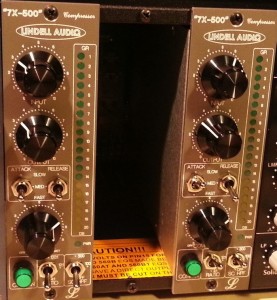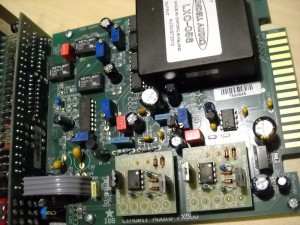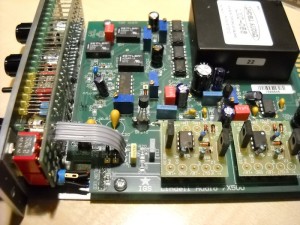Lindell Audio 7X-500 FET compressor (english version)
For a number of reasons, the API 500 spec set has become a de facto standard in the big world of professional audio. Thanks to the VPR Alliance program, every firm can realize modules compliant with this technology. The big advantage for audio engineers is that everyone can build his own preferred audio processing system by mixing and matching modules according his own specific needs and preferences.
by Emiliano Girolami
The trend is now so clear that every audio pro device maker has released an API 500 compatible module set.
Recently a new contender has entered the crowd. Lindell Audio is a company founded by a sweden sound engineer, Tobias Lindell. The man is a mix engineer and producer and has worked with many famous artists and bands (chech HYPERLINK “http://www.bohussound.com/”www.bohussound.com for details).
The devices designed by Tobias reflect his hands on experience. Among those, the compressor 7X-500 (which, obviously, is API 500 compliant) is the Lindell Audio proposal for dynamic processing (other compressors in 19” rack form factor are included in the Lindell’s catalog).
Description
The unit is a FET based compressor, the output is balanced via a custom transformer and a couple of interesting fratures (more details follow) make this module modern and versatile.
The first two knobs work as Input and Output level controls. The amount of compression is controlled with the input level since the threshold is fixed (and not specified in the included manual). Gain reduction can be easly checked thanks to a strip made of 20 LEDs tuned to measure 1dB each (cool and useful). Time response is controlled by two mini switches, one for Attack and the other for Release time. Three are the available positions (Slow, Med e Fast). As of the Attack Time we have 20μSec (Fast), 0,5mSec (Med) and 2mSec (Slow). Release Time has following options: 50mSec (Fast), 80mSec (Med) and 700mSec (Slow). Ratio is controlled in a similar way and the available values are 4:1, 12:1 and 100:1. A useful Side Chain filter can be activated and the cut frequency can be set at 100Hz or 300Hz. The last control is dedicated to the Mix, allowing dry sound to pass through for parallel compression. The last LED lits when power is on and the unit can be thru bypassed via a dedicated button (which gets green when the compressor is active).
The unit is well built, two FETs (BF245) can be found on the neat PCB. A couple of piggy back boards are used for gain stages. Those are a hybrid designs as they are assembled combining integrated op-amps and discrete components (transistors and diodes). Signal flow is controlled by relays to ensure transparency and noiseless switching. The 7X-500 is designed in Sweden and assembled in Poland while the custom output transformer is made in UK. The unit is definitely Made in Europe. It seems robust and reliable.
In the owner manual there is a specific mention of the UA1176 as source of inspiration for this design. Certain parameter values are effectively the same. Same fast attack (20μSec). Release time that starts from the same value (50mSec) and All In option available via the 100:1 compression ratio. The two circuits are different, though, so it is unlikely they will perform in the same way.
You can find ALL the tracks and the audio examples HERE…
The test
No issue from the mechanical point of view. The unit fits perfectly into the Lunch Box frame, the connector is stable and the front panel dimensions are correct.
The 7X-500 has been tested with several sources. The units is musical and adds a touch of roundness to the sound which is a pleasure to listen. This appens even at extreme (close to 20dB) gain reductions. The Side Chain filter is excellent to keep a tight bass spectrum. Very useful is the Mix feature to keep transient detail while the sound is heavily compressed. With fast Attack and slow Release the armonic distortion became evident especially for transient rich (percussive) sources. This distortion might be too much, pay attention to the time settings. The Side Chain and Mix control are very useful to adapt the compressor’s behaviour to different audio material. There is no link option so bus compression can be achieved only with manual alignment of a couple of devides.
With a jazzy female lead vocal the result are great. All the performance details become evident without the compression artifacts. The same result can be achieved with male vox leaving space to low frequencies with the sidechain filter. Acoustic guitar gains a tight bottom ad good accuracy of high frequencies while the dynamic is properly leveled, the same can be said for clean electric guitar. On distorted electric, due to the inherent low dynamic range, seems better to leave gain reduction into the 3-5dB range.
As of drums, the test has been carried out with a snare and a kick tracks roughly recorded during a reharsal session. Even with low quality signals the snare became tight with a clear contribution of the spring to the overall sound. On the kick drum the compressor equilibrates the bottom and the top edges with a little help of a pre-comp equalization.
On electric bass some more tweaking seems necessary to nail a good sound. Listen to the provided audio tracks to have a closer idea of the 7X-500 possibilities.
The tracks have been processed activating the compressor after a while in order to let the listener understand the applied effect.
Final thoughts
The Lindell Audio 7X-500 is a great processor, especially if we consider that the street price (in Europe) is around 290€. The unit is well built and rich of useful features (direct heritage of the designer’s experience). The unit works well either for dynamic control or in pushing forward the program details. It can be used in several cases (only with electric bass we would have preferred other compression technologies) giving good times to the engineers. Given the price/performance ratio, it cannot be missed in your Lunch Box.
Tags: 7X-500, API-500, compressor, FET, Liddell Audio
Trackback from your site.




Comments (2)
Ciro Urselli
| #
Finally, with articles written in English, Audio Central Magazine will have the right spread worldwide on the web!
Reply
Enrico Cosimi
| #
maybe not always there’ll be the translation…
Reply